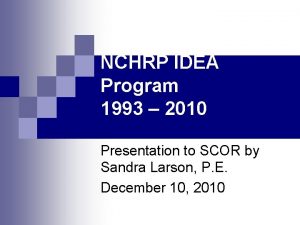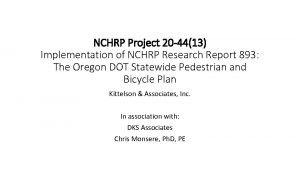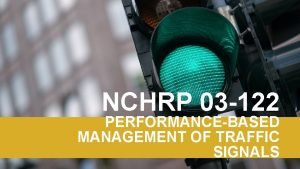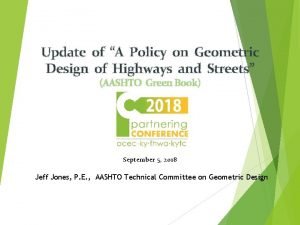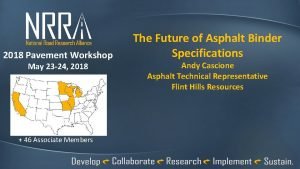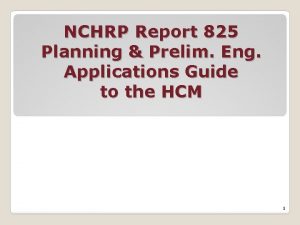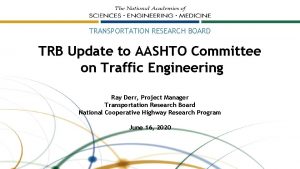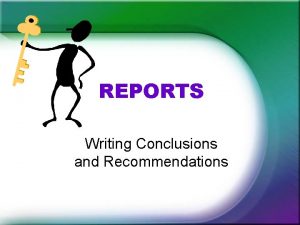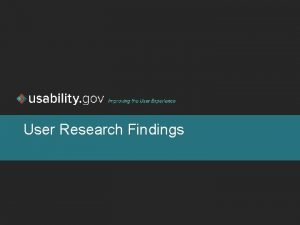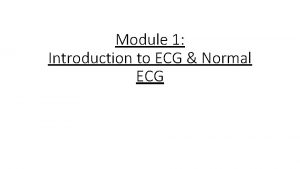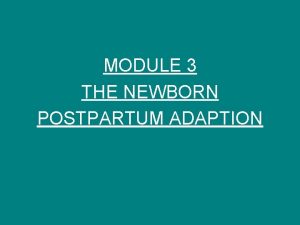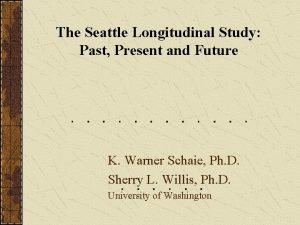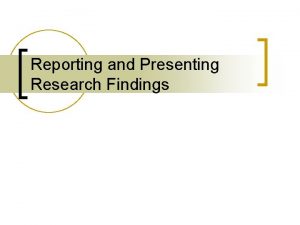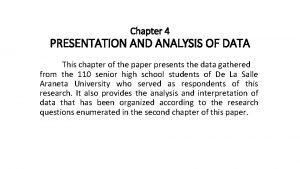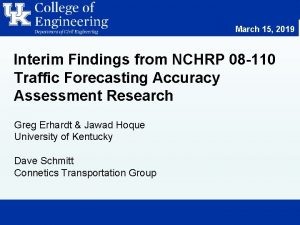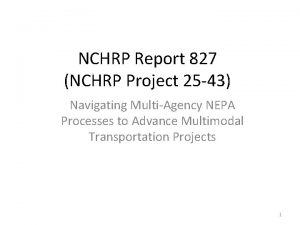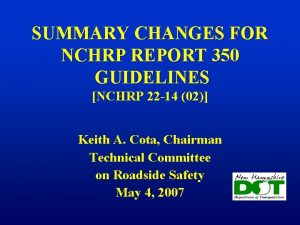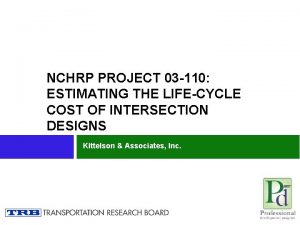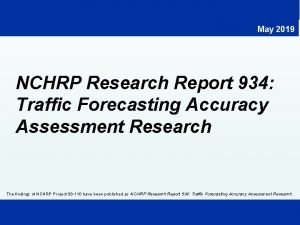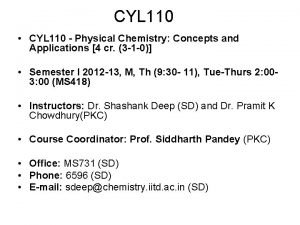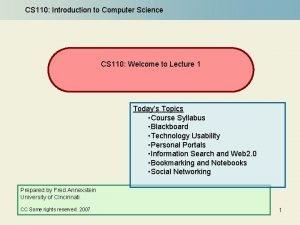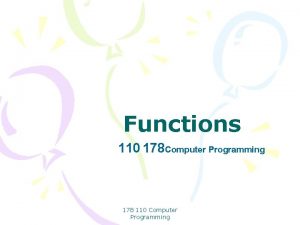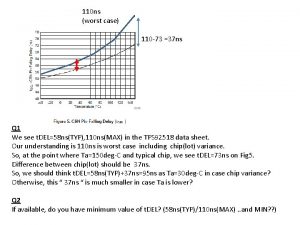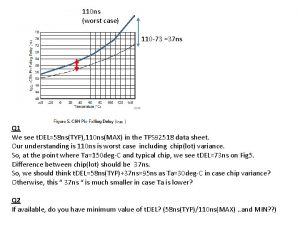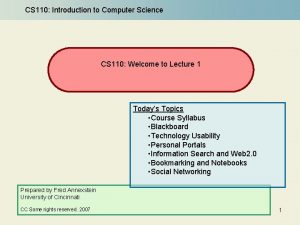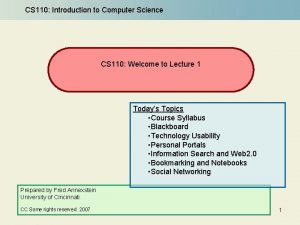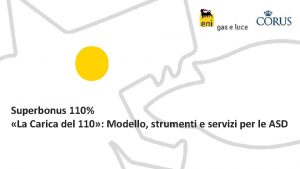March 15 2019 Findings from NCHRP 08 110































- Slides: 31

March 15, 2019 Findings from NCHRP 08 -110 Traffic Forecasting Accuracy Assessment Research Dave Schmitt Connetics Transportation Group Jawad Hoque University of Kentucky Elizabeth Sall Urban. Labs

“The greatest knowledge gap in US travel demand modeling is the unknown accuracy of US urban road traffic forecasts. ” Hartgen, David T. “Hubris or Humility? Accuracy Issues for the next 50 Years of Travel Demand Modeling. ” Transportation 40, no. 6 (2013): 1133– 57. 2

Project Objectives “The objective of this study is to develop a process to analyze and improve the accuracy, reliability, and utility of project-level traffic forecasts. ” -- NCHRP 08 -110 RFP • Accuracy is how well the forecast estimates project outcomes. • Reliability is the likelihood that someone repeating the forecast will get the same result. • Utility is the degree to which the forecast informs a decision. 3

1. Research Approach

Research Question and Approach Question: How accurate are traffic forecasts? • Method: Statistical analysis of actual vs forecast traffic for a large sample of projects after they open. • Output: Distribution of expected traffic volume as a function of forecast volume. Question: What are the sources of forecast error? • Method: "Deep dives" into forecasts of six substantial projects after they open. • Output: Estimated effect of known errors, and remaining unknown error. Question: How can we improve forecasting practice? • Method: Derive lessons from this research and review with practitioners. • Output: Recommendations for how to learn from past traffic forecasts. 5

Challenges -“The lack of availability for necessary data items is a general problem and probably the biggest limitation to advances in the field. ” -Nicolaisen and Driscoll, 2014 Forecast Accuracy Database: Project, forecast and actual traffic information. 2611 unique projects Large-N Analysis Case Studies: 5 projects with model runs Deep Dives 6

2. Large-N Analysis

Forecast Accuracy Database 6 states: FL, MA, MI, MN, OH, WI + 4 European nations: DK, NO, SE, UK Total: 2, 600 projects, 16, 000 segments Open with Counts: 1, 300 projects, 3, 900 segments 8

Large N Analysis About the Methodology • 9

How Accurate Are Traffic Forecasts? On average, the actual traffic volume is about 6% lower than forecast. On average, the actual traffic is about 17% different from forecast. 10

How Accurate Are Traffic Forecasts? Traffic forecasts are more accurate, in percentage terms, for higher volume roads. 95% of forecasts reviewed are “accurate to within half of a lane. ” 11

Large N Results Traffic forecasts are more accurate for: • Higher volume roads • Higher functional classes • Shorter time horizons • Travel models over traffic count trends • Opening years with unemployment rates close to the forecast year • More recent opening & forecast years 12

Estimating Uncertainty Actual ADT Our research provides a means of estimating the range of uncertainty around a forecast using quantile regression. Draw lines so 95% of dots are between the lines Forecast ADT 13

Estimating Uncertainty To draw a line through the middle of the cloud, we use regression. To draw a line along the edge of the cloud, we use quantile regression. It’s the same thing, but for a specific percentile instead of the mean. 14

Quantile Regression Output 46, 000 18, 000 15

3. Deep Dive Results

Deep Dives Projects selected for Deep Dives • Eastown Road Extension Project, Lima, Ohio • Indian River Street Bridge Project, Palm City, Florida • Central Artery Tunnel, Boston, Massachusetts • Cynthiana Bypass, Cynthiana, Kentucky • South Bay Expressway, San Diego, California • US-41 (later renamed I-41), Brown County, Wisconsin 17

Deep Dive Methodology • Collect data: – Public Documents – Project Specific Documents – Model Runs • Investigate sources of errors as cited in previous research: – Employment, Population projections etc. • Adjust forecasts by elasticity analysis • Run the model with updated information 18

Deep Dive Results Project Original Percent Difference from Forecast Eastown Road Extension Project, Lima, Ohio -43% Indian River Bridge, Palm City, Florida Central Artery Tunnel, Boston, Massachusetts Cynthiana Bypass, Cynthiana, Kentucky US 41 (later renamed as I -41), Brown County, Wisconsin Southbay Expressway, San Diego, California -60% -16% -27% -5% Revenue less than projected, leading to bankruptcy of P 3. Remaining percent difference from forecast after adjusting for errors in: Employment -39% Population/Household -38% Car Ownership -37% Fuel Price/Efficiency -34% Travel Time/Speed Employment Population Fuel Price Employment Population External Trips Only -28% -59% -61% -56% -10% -14% -10% -25% 7% Population -4% Fuel Price Socio Economic Growth Border crossing Toll rates Remaining percent difference from forecast after all adjustments -28% -56% -10% -8% -6% The available documentation did not allow the effect of these factors on traffic volume to be quantified. 25

Deep Dives General Conclusions • The reasons forecast inaccuracy are diverse. • Employment, population and fuel price forecasts often contribute to forecast inaccuracy. • External traffic and travel speed assumptions also affect traffic forecasts. • Better archiving of models, better forecast documentation, and better validation are needed. 26

4. Recommendations

1. Use a range of forecasts to communicate uncertainty • Report a range of forecasts. • Quantile regression • If the project were at the low/high end of the forecast range, would it change the decision? 28

2. Archive your forecasts 1. Bronze: Record basic forecast and actual traffic information in a database 2. Silver: Bronze + document forecast in a semistandardized report 3. Gold: Silver + make the forecast reproducible 29

3. Periodically Report the Accuracy • Provides empirical information on uncertainty. • Ensures a degree of accountability and transparency 30

4. Use Past Results to improve forecasting method • Evaluate past forecasts to learn about weaknesses of existing model – Identify needed improvements • Test the ability of the new model to predict those project-level changes – Do the improvements help? • Estimate local quantile regression models – Is my range narrower than my peer’s? We build models to predict change. We should evaluate them on their ability to do so. 31

Why? 1. Giving a range more likely to be “right” 2. Archiving forecasts and data Provides evidence for effectiveness of tools used 3. Data to improve models Testing predictions is the foundation of science Together, the goal is not only to improve forecasts, but to build credibility. 32

5. Archive and Information System

Archive & Information System Desired features: • Stable, long-term archiving • Ability to add reports or model files • Enable multiple users and data sharing • Private/local option • Mainstream and low-cost software Standard data fields! 34

forecastcards https: //github. com/e-lo/forecastcards 35

forecastcarddata https: //github. com/gregerhardt/forecastcarddata 36

Questions & Discussion
 Vignette mutuelle 110/110
Vignette mutuelle 110/110 011 101 001
011 101 001 Poland national anthem lyrics
Poland national anthem lyrics Game data crunch
Game data crunch Grihalakshmi magazine march 2019
Grihalakshmi magazine march 2019 Nchrp idea
Nchrp idea Nchrp 20-44
Nchrp 20-44 + p u r d u e + c o o r d i n a t i o n + d i a g r a m
+ p u r d u e + c o o r d i n a t i o n + d i a g r a m Nchrp 659
Nchrp 659 Nchrp 9-60
Nchrp 9-60 Nchrp 825
Nchrp 825 Transportation research board
Transportation research board Data analysis research example
Data analysis research example Communication of research findings
Communication of research findings Example of conclusion and recommendation in report
Example of conclusion and recommendation in report Reporting research findings
Reporting research findings Example of findings in research
Example of findings in research Desired results parent survey
Desired results parent survey Percussion abdominal assessment
Percussion abdominal assessment Megaloblastic anemia vs pernicious anemia
Megaloblastic anemia vs pernicious anemia Site:slidetodoc.com
Site:slidetodoc.com Findings of qualitative research
Findings of qualitative research Abnormal findings
Abnormal findings What is the seattle longitudinal study
What is the seattle longitudinal study X ray findings in rickets
X ray findings in rickets Cva tenderness test
Cva tenderness test Schaffer and emerson stages of attachment
Schaffer and emerson stages of attachment Ecg findings of heart failure
Ecg findings of heart failure Qualitative vs quantitative data analysis
Qualitative vs quantitative data analysis Presenting research findings
Presenting research findings Chapter 4 data presentation and analysis
Chapter 4 data presentation and analysis Translating research findings to clinical nursing practice
Translating research findings to clinical nursing practice





